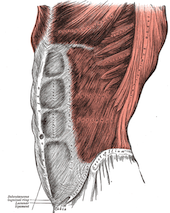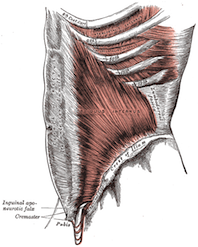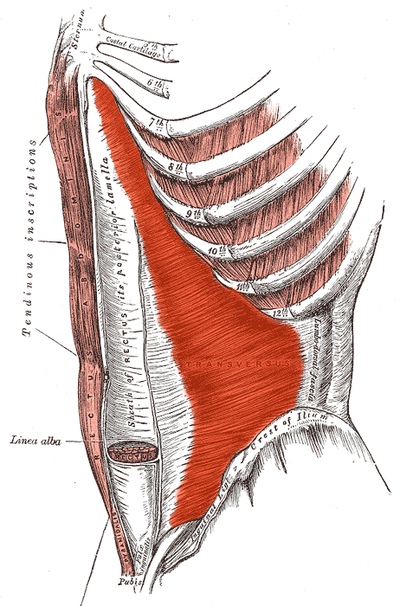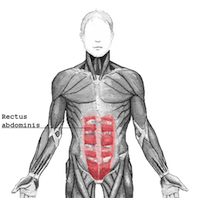Abdominal Muscles
Original Editor - Anne Millar
Top Contributors - Anne Millar, Khloud Shreif, Lucinda hampton, Laura Ritchie, Kim Jackson, Admin, Joao Costa, Scott Buxton, Vidhu Sindwani and Evan Thomas
Introduction[edit | edit source]
The abdominal muscles form the anterior and lateral abdominal wall and consist of the external abdominal obliques, the internal abdominal obliques, the rectus abdominis and the transversus abdominis . Acting together these muscles form a firm wall that protects the viscera and they help to maintain erect posture. In addition the contraction of these muscles helps in expiration and to increase the intra-abdominal pressure such as in sneezing, coughing, micturating, defecating, lifting and childbirth.[1]
External Abdominal Oblique[edit | edit source]
Structure[edit | edit source]
The external abdominal oblique muscle is the largest and most superficial of the four muscles and lies on the sides and front of the abdomen. It is broad and thin with it's muscular portion occupying the side and it's aponeurosis the anterior wall of the abdomen.
Origin: it arises from the external surface and inferior borders of the lower eight ribs. The fibres from the lowest ribs pass nearly vertically downwards.
Insertion: the lower fibres inserted into the anterior half of outer lip the iliac crest, the middle and upper fibres, directed inferiorly and anteriorly, end in an aponeurosis at approximately the mid-clavicular line (that aponeurosis form inguinal ligament) and insert into the linea alba, the pubic crest and the pubic tubercle [2].
Innervation[edit | edit source]
Nerve supply: the upper two-third of external abdominal oblique supplied by the lower six thoracic nervesT7-T11, the lower third supplied by the iliohypogastricL1 and ilioinguinal nerves[3].
Blood supply: the upper 2/3 receive blood supply from branches of lower posterior intercostal and subcostal arteries, lower 1/3 from deep circumflex iliac artery.[4]
Function [edit | edit source]
Both sides acting together, the external abdominal obliques flex the vertebral column by drawing the pubis towards the xiphoid process. Acting unilaterally it results in ipsilateral side flexion and contralateral rotation of the trunk.[5]
Internal Abdominal Oblique[edit | edit source]
Structure[edit | edit source]
The internal abdominal oblique muscle is also a broad thin muscular sheet that lies deep to the external oblique muscle.
Origin: it arises from the thoraco-lumbar fascia, the anterior two-thirds of the iliac crest and the lateral two-thirds of the inguinal ligament.
Insertion: the muscle fibres radiate superomedially and insert into the inferior borders of the lower three ribs and their costal cartilages, the xiphoid process, the linea alba and the symphysis pubis.
Near their insertion the lowest tendinous fibres are joined with similar fibres from the transversus abdominis to form the conjoint tendon[2].[6] [7]
Innervation[edit | edit source]
Nerve supply: the internal abdominal obliques are innervated by the lower six thoracic nerves and the iliohypogastric and ilioinguinal nerves[3].
Blood supply: lower posterior intercostal and subcostal arteries, superior and inferior epigastric arteries, superficial and deep circumflex iliac arteries, posterior lumbar arteries.
Function[edit | edit source]
Acting unilaterally, contraction of the internal oblique results in ipsilateral side flexion and rotation of the trunk.[5] It acts with the external oblique muscle of the opposite side to achieve this torsional movement of the trunk. It also acts to compress the abdominal viscera, pushing them up into the diaphragm, resulting in a forced expiration.
Transversus Abdominis[edit | edit source]
Structure[edit | edit source]
The transversus abdominis muscle is the deepest of the abdominal muscles, lying internally to the internal abdominal obliques. It is a thin sheet of muscle whose fibres run transversely anteriorly perpendicular to linea alba. it frames the lateral abdominal muscle
Origin: it arises as fleshy fibres from the deep surface of the lower six costal cartilages, the lumbar fascia, the anteror two-thirds of the iliac crest and the lateral third of the inguinal ligament.
Insertion: it inserts into the xiphoid process, the linea alba and the symphsis pubis. The lowest tendinous fibres join similar fibres from the interior obliques to form the conjoint tendon which is fixed to the pubic crest and the pectineal line[2].[8]
Innervation[edit | edit source]
Nerve supply: the transversus abdominus muscle is innervated by the lower six thoracic nerves and the iliohypogastric L1 and ilioinguinal nerves L1[3].
Blood supply: same as internal abdominal oblique; lower posterior intercostal and subcostal arteries, superior and inferior epigastric arteries, superficial and deep circumflex iliac arteries, posterior lumbar arteries.
Function[edit | edit source]
Contraction of the transversus abdominis has a corset like effect, narrowing and flattening the abdomen. It's primary function is to stabilise the lumbar spine and pelvis before movement of the lower and /or upper limbs occur[9].
Rectus Abdominis[edit | edit source]
Structure[edit | edit source]
The rectus abdominis is a long strap muscle that extends the entire length of the anterior abdominal wall. It is broader above and lies close to the midline, being separated from it's fellow by the linea alba.
Origin: it arises by two heads from the anterior aspect of the symphysis pubis and the pubic crest.
Insertion: it inserts into the 5th , 6th and 7th costal cartilages and the xiphoid process.
Each rectus abdominis is divided into three distinct segments by three transverse fibrous intersections, one at the level of the xiphoid process, one at the umbilicus and one halfway between the two. The rectus abdominis is enclosed between the aponeuroses of the external and internal obliques and transversus abdominis which form the rectus sheath[2].[10]
Innervation[edit | edit source]
Nerve supply: the rectus abdominis muscle is innervated by the lower six thoracic nerves[3].
Blood supply: superior and inferior epigastric arteries; inferior is the main supply of rectus abdominis[11]
Function[edit | edit source]
The rectus abdominis is an important postural muscle. With a fixed pelvis, contraction results in flexion of the lumbar spine. When the ribcage is fixed contraction results in a posterior pelvic tilt. It also plays an important role in forced expiration and in increasing intra-abdominal pressure.[5]
| [12] |
Pyramidalis[edit | edit source]
Structure[13][edit | edit source]
Pyramidalis with rectus abdominis contribute to form the anterior abdominal wall. It's absent in 20% of the population and has less significant role, triangular muscle.
Origin: it arises from symphysis pubic and pubic crest
Insertion: decrease in size as it ascends and inserts medially to linea alba as apointed apex.
Innervation[edit | edit source]
Nerve supply: It is innervated by subcostal nerve T12
Blood supply: the main arterial supply from the inferior epigastric supply and the deep circumflex iliac artery to a lesser extent.
Function[edit | edit source]
When they contract tense the linea alba
References[edit | edit source]
- ↑ Drake RL, Vogyl AW, Mitchell AW. Gray's anatomy for students. 3rd edition. Philadelphia: Churchill Livingstion Elsevier; 2015. 282p.
- ↑ 2.0 2.1 2.2 2.3 Gray H. Grays Anatomy. 37th ed. Edinburgh: Churchill Livingstone, 1989.
- ↑ 3.0 3.1 3.2 3.3 Mantle J, Haslam J, Barton S. Physiotherapy in Obstetrics and Gynaecology. 2nd Ed. Edinburgh: Butterworth Heinemann, 2004
- ↑ https://www.kenhub.com/en/library/anatomy/external-abdominal-oblique-muscle
- ↑ 5.0 5.1 5.2 Drake RL, Vogyl AW, Mitchell AW. Gray's anatomy for students. 3rd edition. Philadelphia: Churchill Livingstion Elsevier; 2015. 286p
- ↑ Wikipedia. Internal Abdominal Obliques. http://en.wikipedia.org/wiki/Abdominal_internal_muscle
- ↑ KENHUBhttps://www.kenhub.com/en/library/anatomy/internal-abdominal-oblique-muscle
- ↑ Wikipedia. Transversus Abdominis. http://en.wikipedia.org/wiki/Transversis_abdominis_muscle
- ↑ Lee D. The Pelvic Girdle. 2nd Ed. Edinburgh: Churchill Livingstone, 1999.
- ↑ Wikipedia. Rectus Abdominis. http://en.wikipedia/org.wiki/Rectus_abdominis_muscle
- ↑ https://www.kenhub.com/en/library/anatomy/anterior-abdominal-muscles
- ↑ Anatomy Zone. Muscles of the Anterior Abdominal Wall-3D Anatomy Tutorial. Available from: http://www.youtube.com/watch?v=mvOajxO8mXO [last accessed 11/07/15]
- ↑ https://www.kenhub.com/en/library/anatomy/pyramidalis-muscle










